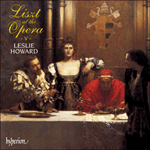As he did so often in the early fantasies, Liszt composed his piano work within the year of the first performance of Halévy’s most celebrated work
La juive. Using motifs from Acts 3 and 5, Liszt produced a work of much originality; the shape of the opening Molto allegro feroce is entirely his, even if the thematic fragments are Halévy’s, and it is not until the recognizable martial chorus (Marziale molto animato, from bar 131) that he uses a whole theme. The succeeding
Boléro is only loosely based on Halévy, but is the theme for two variations. The Finale (Presto agitato assai) begins as if it were a third variation but gives way to frenetically foreshortened recollections of the march and the introductory material. The ferocious opening foreshadows the ‘infernal’ music of Liszt’s Weimar period, but also shows immediate kinship with the
Valse infernale from Meyerbeer’s
Robert le diable, with which the
La juive fantasy was reissued—along with the
Huguenots fantasy and the
Don Giovanni fantasy—in about 1842.
from notes by Leslie Howard © 1998
Comme si souvent pour ses premières fantaisies, Liszt composa son œuvre pour piano l’année même de la première de l’œuvre la plus célèbre d’Halévy,
La juive. À l’aide de motifs des Actes III et V, il produisit une œuvre d’une grande originalité; la forme du Molto allegro feroce initial est entièrement la sienne, même si les fragments thématiques sont ceux d’Halévy, et il n’utilise pas de thème entier avant le reconnaissable chœur martial (Marziale molto animato, à partir de la mesure 131). Le
Boléro suivant ne repose que légèrement sur Halévy, mais sert de thème à deux variations. Le Finale (Presto agitato assai) débute comme s’il y avait une troisième variation mais cède la place à des réminiscences, frénétiquement réduites, de la marche et du matériau introductif. L’ouverture féroce préfigure la musique «infernale» de la période weimarienne de Liszt, tout en présentant une parenté immédiate avec la
Valse infernale du
Robert le diable de Meyerbeer, republiée avec la fantaisie
La juive—et les fantaisies
Huguenots et
Don Giovanni—aux alentours de 1842.
extrait des notes rédigées par Leslie Howard © 1998
Français: Hypérion
Liszt komponierte dieses Klavierwerk, wie viele seiner frühen Fantasien, im Jahr der Erstaufführung von Halévys gefeiertem Werk
La juive. Mit Motiven aus dem 3. und 5. Akt schuf Liszt ein Werk großer Originalität. Die Form des eröffnenden Molto allegro feroce ist charakteristisch für Liszt, wenn auch die thematischen Fragmente eindeutig in der Tradition Halévys stehen. Und erst mit dem erkennbar kriegerischen Chor (Marziale molto animato, ab Takt 131) verwendet er ein vollständiges Thema. Der anschließende
Boléro basiert zwar nur vage auf Halévy, dient aber als Thema für zwei Variationen. Das Finale (Presto agitato assai) beginnt, als wäre es eine dritte Variation, macht aber schließlich den Weg frei für einen rasanten, kürzer wirkenden Moment der Erinnerung an den Marsch und den Stoff der Einleitung. Die wilde Eröffnung ist ein Vorbote der „höllischen“ Musik der Weimarer Zeit Liszts, sie weist aber auch eine unmittelbare Verwandschaft zum
Valse infernale aus Meyerbeers
Robert le diable auf, mit dem die
La juive-Fantasie etwa um 1842—zusammen mit der
Hugenotten-Fantasie und der
Don Giovanni-Fantasie—neuveröffentlicht wurde.
aus dem Begleittext von Leslie Howard © 1998
Deutsch: Michael Stoffl


 Liszt: Complete Piano Music
Liszt: Complete Piano Music Liszt: The complete music for solo piano, Vol. 50 - Liszt at the Opera V
Liszt: The complete music for solo piano, Vol. 50 - Liszt at the Opera V
